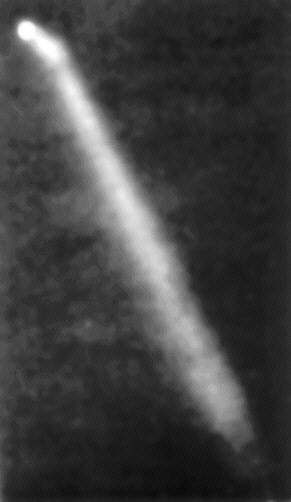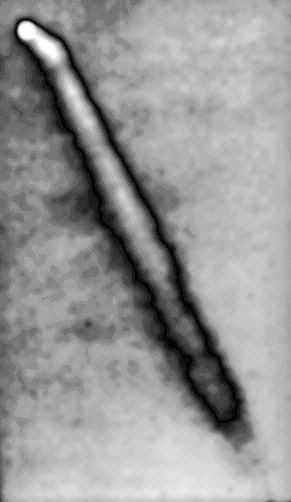


Summary. Some photographs of UFOs show that these objects are often positioned beside subtle toroidal patterns of distortion in light propagation. Other photographs show that light beams are bent in the vicinity of UFOs. These observations suggest that the UFOs' propulsion system generates localized curvilinear gravitational field gradients.
In 1942, Los Angeles, California, was the scene of a UFO being fired upon by artillery on the ground. An original newspaper photo of the event shows a brightly lit object in the sky surrounded by exploding artillery shells. As pointed out by Bruce Macabbee, a searchlight beam passing nearby is deflected downward slightly. Further analysis of the photo shows a toroidal form just above the object. The left panel of Figure 1 shows the path of the light beam as it passes over the object. The middle panel shows the object cropped and slightly enlarged. The right panel shows the enhanced object with the toroidal shape clearly visible at the top. Perhaps the light beam was bent by a field in the shape of the torus.
| Bent light beam marked | Cropped object | Enhanced object |
|---|---|---|
 |
 |
 |
| Figure 1. Photograph of the Battle of Los Angeles. | ||
This example is one of a number of photos where UFOs are accompanied by toroidal distortions (see here).
As in the above photo and in the earlier report, UFOs are often found on or near the surface of a torus. Further, analysis of images of the Hutchison effect (see here) showed similar insubstantial tori in regions of space where anti-gravitational effects occurred. If the tori in the two phenomena have similar origins, the UFO would appear to ride an oriented gravitational field gradient to achieve motion. A photo of a UFO caught in a laser light show (see Figure 2) is consistent with this interpretation. Figure 3a shows the UFO cropped from the original image, and Figure 3b shows a contrast-enhanced version of the cropped image. The latter shows that the less intense light beams near the UFO are bent as would be expected in the presence of a curved gravitational field gradient.
 |
| Figure 2 |
 |
 |
| a | b |
| Figure 3 | |
Another case of light bending near a UFO was docmented as the Norwood Searchlight Incident of 1949. A photograph of a searchlight directed at a UFO shows a sharp 26.5 degree bend in the light beam near the UFO. As shown in Figure 4a, the UFO seems to be attracting the beam toward itself. However, this implied causal connection may be erroneous since there is a profile of a torus positioned near the point where the light beam bends. Figure 4b is a filtered version of the image that shows the torus more clearly. Figure 4c outlines the torus with the help of a graphic overlay. The light beam deviates as it passes by the torus as would be expected if the torus were a source of artificial gravity.
 |
 |
 |
| a | b | c |
| Figure 4 | ||
The 1966 Burkes Flat Case reports that car headlights were attracted toward a landed UFO. No picture is available from that event. Again, this suggests the presence of a strong, abnormal gravitational field in the vicinity of the UFO.
The use of artificial gravity for propulsion is not a new idea (see here), although no successful technology yet exists in the public domain. A flying machine would be able to use the gravitational field gradient for propulsion by repetitively creating a field oriented in the desired direction of motion. The process would be somewhat analogous to skiing along a flat surface by temporarily changing the slope immediately ahead of the skis. The UFO pictures often show multiple toroidal optical effects at various distances and orientations relative to the UFO. Therefore, it seems that the localized gravitational field may be created anew as needed, and each instantiation can persist for some time after the UFO has moved on.